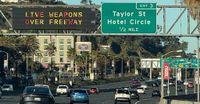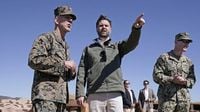On October 18, 2025, a high-profile military celebration at Camp Pendleton in Southern California took an alarming turn when an artillery shell exploded prematurely over Interstate 5, showering shrapnel onto vehicles belonging to the California Highway Patrol—including those escorting Vice President JD Vance. The incident, which unfolded during a live-fire demonstration marking the Marine Corps’ 250th anniversary, has sparked heated debate over public safety, military tradition, and political responsibility, with officials and eyewitnesses offering sharply differing perspectives on what went wrong and why.
The demonstration was billed as a showcase of the Navy-Marine Corps team’s ability to integrate across air, land, and sea—a nod to both the Corps’ enduring role as America’s force in readiness and the nation’s upcoming Semiquincentennial. The event drew thousands to Red Beach at Camp Pendleton, including Vice President Vance, Secretary of Defense Pete Hegseth, and a host of dignitaries and service members. The White House even filmed the display for a primetime television special set to air November 9, according to The San Diego Union-Tribune.
But as Marines fired M777 howitzers from the beach, sending 155-millimeter shells arcing over a closed 17-mile stretch of Interstate 5, something went awry. According to a California Highway Patrol report cited by The New York Times, one of the shells detonated overhead, sending metal fragments raining down onto a CHP patrol car and motorcycle parked on a freeway ramp. Officers described hearing what sounded like pebbles striking their vehicles and the pavement. One officer saw a two-inch piece of shrapnel hit the hood of his patrol car, leaving a visible dent. Shrapnel was also found on the road near the motorcycle.
“This was an unusual and concerning situation,” said Tony Coronado, the California Highway Patrol’s Border Division Chief, in a statement reported by Task & Purpose. “It is highly uncommon for any live-fire or explosive training activity to occur over an active freeway. As a Marine myself, I have tremendous respect for our military partners, but my foremost responsibility is ensuring the safety of the people of California and the officers who protect them.”
No injuries were reported, but the incident prompted an immediate halt to further artillery firing over the freeway. The Marine Corps, according to spokesperson Capt. Gregory Dreibelbis, suspended all firing shortly after the mishap and launched an investigation into the premature detonation of the round. “We are committed to determining the incident’s root cause and applying findings to future missions,” said Lt. Col. Lindsay Pirek, a spokeswoman for the First Marine Expeditionary Force, in a statement to The New York Times.
The shell was fired at 1:46 p.m. from White’s Beach, roughly three-quarters of a mile south of Las Pulgas Road, where highway patrol officers had parked after escorting Vice President Vance to the event. The exercise, initially planned to involve around 60 shells, was abruptly terminated after the explosion. Officers swept the area for additional fragments but found none, and the interstate was reopened to traffic at 2:20 p.m.
The closure of Interstate 5, a vital artery along the Pacific coast that carries roughly 80,000 travelers and $94 million in freight daily, was itself a point of contention. Governor Gavin Newsom ordered the 17-mile stretch closed for four hours, citing safety concerns after learning that military officials had not planned to request a closure. The decision, made after practice firings the previous evening and a request from event organizers for signage stating “overhead fire in progress,” caused significant traffic delays and halted passenger rail services running parallel to the freeway, as reported by The Guardian.
Governor Newsom was outspoken in his criticism of the event, calling it an “absurd show of force” and “totally uncalled for.” In a statement to The New York Times and on social media, he declared, “We love our Marines and owe a debt of gratitude to Camp Pendleton, but next time, the Vice President and the White House shouldn’t be so reckless with people’s lives for their vanity projects.” He added, “Firing live rounds over a busy highway isn’t just wrong – it’s dangerous. Using our military to intimidate people you disagree with isn’t strength – it’s reckless, it’s disrespectful, and it’s beneath the office he holds.”
California Highway Patrol’s Coronado echoed the unusual nature of the exercise, stating, “It is highly uncommon for any live-fire or explosive training activity to occur near an active freeway.” An active-duty Marine artillery officer and a former noncommissioned officer, both speaking to The New York Times on condition of anonymity, described the decision to fire howitzers over the freeway as unprecedented in their experience, noting that previous artillery training at Camp Pendleton had taken place on approved ranges east of the interstate, considered much safer.
The Marine Corps, for its part, asserted that all necessary precautions had been taken. In a statement issued before the demonstration, officials said, “We have conducted a detailed risk assessment. All participants will be briefed, medical, fire, and emergency assets will be on site, and multiple rehearsals will be conducted. All air, surface, and ground movements are scripted and rehearsed in accordance with standard operating procedures and established safety checklists.” Notably, the Corps had not requested the freeway closure, maintaining that the exercise would comport with established protocols and did not require disruption of public roads.
Political reactions to the incident fell along familiar lines. Governor Newsom, a Democrat, accused the White House of “putting ego over responsibility.” Representative Darrell Issa, whose district lies east of Camp Pendleton, fired back, calling Newsom’s opposition a “spiteful publicity stunt.” A spokesperson for Vice President Vance, William Martin, told The New York Times, “If Gavin Newsom wants to oppose the training exercises that ensure our Armed Forces are the deadliest and most lethal fighting force in the world, then he can go right ahead.” Martin also accused Newsom of misleading the public about the safety risks involved.
Meanwhile, the incident became fodder for broader public debate. About 35 protesters gathered outside Camp Pendleton during the demonstration, voicing concerns about the display and the closure’s impact on the community. The event’s filming for a White House primetime special only heightened scrutiny, with critics arguing that public safety had been sacrificed for political spectacle.
Technical explanations for the mishap remain under investigation. An active-duty Marine told The New York Times that a likely cause was a fault in the projectile’s fuze—a device designed to trigger the shell’s explosion at a specific time or location. Such accidents are exceedingly rare, according to Marines familiar with artillery operations.
As the dust settles, the incident at Camp Pendleton stands as a stark reminder of the complexities—and risks—of blending military tradition with public spectacle. With investigations ongoing and political tempers still flaring, questions about how best to honor the nation’s armed forces while safeguarding the public remain as urgent as ever.


